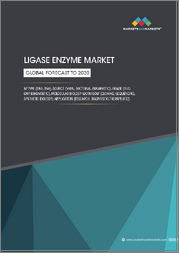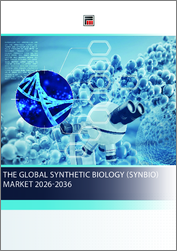
|
시장보고서
상품코드
1569488
합성생물학 시장 규모, 점유율, 성장 분석 : 툴별, 기술별, 용도별, 지역별 - 산업 예측(2024-2031년)Synthetic Biology Market Size, Share, Growth Analysis, By Tool, By Technology, By Application, By Region - Industry Forecast 2024-2031 |
||||||
합성생물학 세계 시장 규모는 2022년 113억 달러로 2023년 141억 8,000만 달러에서 2031년 872억 7,000만 달러로 예측기간(2024-2031년) 동안 연평균 25.5% 성장할 것으로 예상됩니다.
합성생물학 시장은 기술 혁신과 지속가능한 대안에 대한 수요 증가가 주요 요인으로 작용하여 향후 몇 년 동안 강력한 성장을 보일 것으로 예상됩니다. 유전자 편집 기술, 특히 Cas9과 CRISPR의 주요 발전은 합성 유전자 합성의 개선과 함께 합성생물학 응용의 효율성과 비용 효율성을 높이고 있습니다. 이는 환경 문제에 대한 관심과 지속가능성에 대한 관심이 높아지면서 친환경 화학제품, 생분해성 소재, 바이오연료 등 지속가능한 솔루션에 대한 관심이 높아지면서 더욱 가속화되고 있습니다. 그러나 유전자 변형, 환경 영향, 바이오 안전성에 대한 논의 등 윤리적, 규제적 장애물로 인한 도전에 직면해 있으며, 이는 상업화와 현재 진행 중인 연구 이니셔티브 모두에 걸림돌이 될 수 있습니다. 이러한 장애물에도 불구하고 낙관적인 전망은 변함이 없습니다. 특히 첨단 치료와 개인 맞춤형 의료의 출현은 지금까지 치료할 수 없었던 질병을 해결함으로써 헬스케어에 혁명을 가져올 것으로 기대되고 있습니다. 이처럼 합성생물학 시장은 기술적 진보와 사회적 요구가 혁신을 촉진하는 한편, 규제 프레임워크는 윤리적 고려사항을 해결하기 위해 진화하고 있는 교차로에 놓여 있습니다.
목차
소개
- 조사 목적
- 정의
- 시장 범위
조사 방법
- 정보 조달
- 2차 데이터 소스와 1차 데이터 소스
- 시장 규모 예측
- 시장 상정과 제한
주요 요약
- 시장 개요 전망
- 공급 수요 동향 분석
- 부문별 기회 분석
시장 역학과 전망
- 시장 역학
- 성장 촉진요인
- 기회
- 성장 억제요인
- 과제
- Porters 분석
주요 시장 인사이트
- 기술 분석
- 특허 분석
- 가격 분석
- 규제 분석
- 밸류체인 분석
- 시장 생태계
- 혁신 매트릭스
- 주요 투자 분석
- 주요 성공요인
- 경쟁 정도
합성생물학 시장 : 툴별
- 시장 개요
- 올리고뉴클레오티드·합성 DNA
- 효소
- 클로닝 기술 키트
- 합성 세포
- 섀시 유기체
- 이종 핵산
합성생물학 시장 : 기술별
- 시장 개요
- 유전자 합성
- 유전체 공학
- 시퀀싱, 바이오인포매틱스
- 부위 특이적 변이 도입
- 클로닝
- 측정·모델링
- 미세유체
- 나노기술
합성생물학 시장 : 용도별
- 시장 개요
합성생물학 시장 규모 : 지역별
- 시장 개요
- 북미
- 미국
- 캐나다
- 유럽
- 독일
- 스페인
- 이탈리아
- 프랑스
- 영국
- 기타 유럽
- 아시아태평양
- 중국
- 인도
- 일본
- 한국
- 기타 아시아태평양
- 라틴아메리카
- 브라질
- 기타 라틴아메리카
- 중동 및 아프리카(MEA)
- GCC 국가
- 남아프리카공화국
- 기타 중동 및 아프리카
경쟁 상황
- 상위 5개사의 비교
- 주요 기업의 시장 포지셔닝(2023년)
- 주요 시장 기업이 채용한 전략
- 시장의 최근 활동
- 주요 기업의 시장 점유율(2023년)
주요 기업 개요
- [if!supportLists][endif]Thermo Fisher Scientific, Inc.(US)
- Merck KGaA(Germany)
- Agilent Technologies(US)
- Novozymes(Denmark)
- Ginkgo Bioworks(US)
- Amyris(US)
- Precigen, Inc.(US)
- GenScript(China)
- Twist Bioscience(US)
- Synthetic Genomics(US)
- Codexis, Inc.(US)
- Synthego(US)
- Creative Enzymes(US)
- Eurofins Scientific(Luxembourg)
- Bota Biosciences Inc.(China)
- Creative Biogene(US)
- Enbiotix, Inc.(US)
- Illumina, Inc.(US)
- New England Biolabs(US)
- Pareto Bio, Inc.(US)
Global Synthetic Biology Market size was valued at USD 11.3 Billion in 2022 and is poised to grow from USD 14.18 Billion in 2023 to USD 87.27 Billion by 2031, at a CAGR of 25.5% over the forecast period (2024-2031).
The synthetic biology market is poised for robust growth in the coming years, driven largely by technological innovations and an increasing demand for sustainable alternatives. Key advancements in gene editing technologies, particularly Cas9 and CRISPR, along with improvements in synthetic gene synthesis, are enhancing the efficiency and cost-effectiveness of synthetic biology applications. This is further fueled by the rising interest in sustainable solutions, such as green chemicals, biodegradable materials, and biofuels, as environmental concerns and the push for sustainability gain prominence. However, the market faces challenges stemming from ethical and regulatory hurdles, including debates over genetic modifications, environmental impacts, and biosafety, which may hinder both commercialization and ongoing research initiatives. Despite these obstacles, the landscape remains optimistic, particularly with the emergence of advanced therapies and personalized medicine, which hold the promise to revolutionize healthcare by addressing previously untreatable conditions. As such, the synthetic biology market stands at a crossroads, with technological progress and societal demands pushing for innovation, while regulatory frameworks evolve to address ethical considerations.
Top-down and bottom-up approaches were used to estimate and validate the size of the global synthetic biology market and to estimate the size of various other dependent submarkets. The research methodology used to estimate the market size includes the following details: The key players in the market were identified through secondary research, and their market shares in the respective regions were determined through primary and secondary research. This entire procedure includes the study of the annual and financial reports of the top market players and extensive interviews for key insights from industry leaders such as CEOs, VPs, directors, and marketing executives. All percentage shares split, and breakdowns were determined using secondary sources and verified through Primary sources. All possible parameters that affect the markets covered in this research study have been accounted for, viewed in extensive detail, verified through primary research, and analyzed to get the final quantitative and qualitative data.
global synthetic biology Market Segmental Analysis
The Global Synthetic Biology Market is segmented by Tool, Application, Technology, and Region. Based on Tool, the market is segmented into Oligonucleotides and Synthetic DNA, Enzymes, Cloning Technologies Kits, Synthetic Cells, Chassis Organisms, and Xeno-Nucleic Acids. Based on Application, the market is segmented into Medical Application, Pharmaceuticals, Drug Discovery and Therapeutics, Other Medical Application, Artificial Tissue and Tissue Regeneration, Industrial Applications, Other Industries, Food & Agriculture, Environmental Applications. Based on Technology, the market is segmented into Gene Synthesis, Genome Engineering, Sequencing, Bioinformatics, Site-directed Mutagenesis, Cloning, Measurement and Modelling, Microfluidics, and Nanotechnology. By Region, the market is segmented into North America, Europe, Asia-Pacific, Middle East and Africa, and Latin America.
Driver of the global synthetic biology Market
The global synthetic biology market is being significantly driven by the advancements in healthcare and agriculture, where innovative therapies, diagnostics, and vaccines are being developed at an unprecedented pace. The ability of synthetic biology to engineer microorganisms and plants has revolutionized the pharmaceutical sector, enabling the rapid production of targeted treatments and improved diagnostics. Simultaneously, in agriculture, genetically tailored crops designed for enhanced resistance against diseases and pests contribute to greater agricultural productivity and food security, addressing critical global challenges. This dual impact on healthcare and agriculture not only sparks market growth but also fosters broader societal benefits, thereby driving further investment and innovation in synthetic biology.
Restraints in the global synthetic biology Market
The high initial costs associated with the development of synthetic biology technologies serve as a significant market restraint for the global synthetic biology market. These financial barriers limit scalability and accessibility, particularly for smaller companies and emerging economies. Additionally, the complexities involved in engineering, designing, and integrating synthetic biological systems pose substantial challenges, potentially undermining the reliability and efficiency of these technologies. As a result, these factors could deter investment and innovation, slowing the overall growth of the market and limiting the effectiveness of synthetic biology solutions in addressing various biotechnological needs.
Market Trends of the global synthetic biology Market
The global synthetic biology market is increasingly trending towards the integration of epigenetic technologies, as new entrants strive to address the complexities of engineered gene expression. The dynamic interplay of epigenetics and DNA sequences often leads to inconsistent outcomes, prompting innovative solutions that enhance the reliability and predictability of synthetic constructs. Startups and established firms alike are leveraging advancements in epigenetic engineering to refine genetic modifications, ensuring better control over gene activity. This focus on epigenetics is expected to drive growth in the sector, as it enables developers to create more sophisticated and effective biotechnological applications across various industries.
Table of Contents
Introduction
- Objectives of the Study
- Definitions
- Market Scope
Research Methodology
- Information Procurement
- Secondary & Primary Data Sources
- Market Size Estimation
- Market Assumptions & Limitations
Executive Summary
- Market Overview Outlook
- Supply Demand Trend Analysis
- Segmental Opportunity Analysis
Market Dynamics & Outlook
- Market Dynamics
- Drivers
- Opportunities
- Restraints
- Challenges
- Porters Analysis
- Competitive rivalry
- Threat of Substitute Products
- Bargaining Power of Buyers
- Threat of New Entrants
- Bargaining Power of Suppliers
Key Market Insights
- Technology Analysis
- Patent Analysis
- Pricing Analysis
- Regulatory Analysis
- Value Chain Analysis
- Ecosystem of the Market
- Innovation Matrix
- Top Investment Analysis
- Key Success Factor
- Degree of Competition
Synthetic Biology Market by Tool
- Market Overview
- Oligonucleotides and Synthetic DNA
- Enzymes
- Cloning Technologies Kits
- Synthetic Cells
- Chassis Organisms
- Xeno-nucleic Acids
Synthetic Biology Market by Technology
- Market Overview
- Gene Synthesis
- Genome Engineering
- Sequencing, Bioinformatics
- Site-directed Mutagenesis
- Cloning
- Measurement and Modelling
- Microfluidics
- Nanotechnology
Synthetic Biology Market by Application
- Market Overview
Synthetic Biology Market Size by Region
- Market Overview
- North America
- USA
- Canada
- Europe
- Germany
- Spain
- Italy
- France
- UK
- Rest of Europe
- Asia Pacific
- China
- India
- Japan
- South Korea
- Rest of Asia-Pacific
- Latin America
- Brazil
- Rest of Latin America
- Middle East & Africa (MEA)
- GCC Countries
- South Africa
- Rest of MEA
Competitive Landscape
- Top 5 Player Comparison
- Market Positioning of Key Players, 2023
- Strategies Adopted by Key Market Players
- Recent Activities in the Market
- Key Companies Market Share (%), 2023
Key Company Profiles
- [if !supportLists] [endif] Thermo Fisher Scientific, Inc. (US)
- Company Overview
- Business Segment Overview
- Financial Updates
- Key Developments
- Merck KGaA (Germany)
- Company Overview
- Business Segment Overview
- Financial Updates
- Key Developments
- Agilent Technologies (US)
- Company Overview
- Business Segment Overview
- Financial Updates
- Key Developments
- Novozymes (Denmark)
- Company Overview
- Business Segment Overview
- Financial Updates
- Key Developments
- Ginkgo Bioworks (US)
- Company Overview
- Business Segment Overview
- Financial Updates
- Key Developments
- Amyris (US)
- Company Overview
- Business Segment Overview
- Financial Updates
- Key Developments
- Precigen, Inc. (US)
- Company Overview
- Business Segment Overview
- Financial Updates
- Key Developments
- GenScript (China)
- Company Overview
- Business Segment Overview
- Financial Updates
- Key Developments
- Twist Bioscience (US)
- Company Overview
- Business Segment Overview
- Financial Updates
- Key Developments
- Synthetic Genomics (US)
- Company Overview
- Business Segment Overview
- Financial Updates
- Key Developments
- Codexis, Inc. (US)
- Company Overview
- Business Segment Overview
- Financial Updates
- Key Developments
- Synthego (US)
- Company Overview
- Business Segment Overview
- Financial Updates
- Key Developments
- Creative Enzymes (US)
- Company Overview
- Business Segment Overview
- Financial Updates
- Key Developments
- Eurofins Scientific (Luxembourg)
- Company Overview
- Business Segment Overview
- Financial Updates
- Key Developments
- Bota Biosciences Inc. (China)
- Company Overview
- Business Segment Overview
- Financial Updates
- Key Developments
- Creative Biogene (US)
- Company Overview
- Business Segment Overview
- Financial Updates
- Key Developments
- Enbiotix, Inc. (US)
- Company Overview
- Business Segment Overview
- Financial Updates
- Key Developments
- Illumina, Inc. (US)
- Company Overview
- Business Segment Overview
- Financial Updates
- Key Developments
- New England Biolabs (US)
- Company Overview
- Business Segment Overview
- Financial Updates
- Key Developments
- Pareto Bio, Inc. (US)
- Company Overview
- Business Segment Overview
- Financial Updates
- Key Developments



















